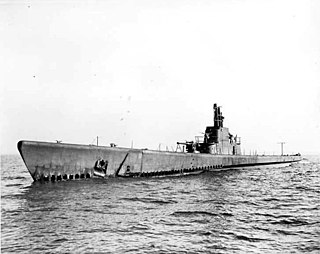
USS Corvina (SS-226), a Gato-class submarine, was the only ship of the United States Navy to be named for the corvina.
USS Barbel (SS-316), a Balao-class submarine, was the first ship of the United States Navy to be named for the barbel, a fish commonly called a minnow or carp.

USS Capelin (SS-289), a Balao-class submarine, was the only ship of the United States Navy to be named for the capelin, a small fish of the smelt family. She is credited with having sunk 3,127 gross register tons of shipping on her single war patrol.

USS Runner (SS-275) was a Gato-class submarine, the first ship of the United States Navy to be named for the runner, an amberfish inhabiting subtropical waters, so called for its rapid leaps from the water.

USS Herring (SS-233), a Gato-class submarine, was the only ship of the United States Navy to be named for the herring.

USS Escolar (SS-294), a Balao-class submarine, was the only ship of the United States Navy to be named for the escolar.

USS Darter (SS-227), a Gato-class submarine, was the first ship of the United States Navy to be named for the darter.

USS Flier (SS-250) was a Gato-class submarine, was the only ship of the United States Navy to be named for the flier.

USS Lionfish (SS-298), a Balao-class submarine, was the only ship of the United States Navy named for the lionfish, a scorpaenid fish native to the Pacific and an invasive species found around the Caribbean. She was designated a National Historic Landmark in 1986, and is now on display at Battleship Cove in Fall River, Massachusetts.

USS Flounder (SS-251), a Gato-class submarine, was the only ship of the United States Navy to be named for the flounder.

USS Pipefish (SS-388/AGSS-388), a Balao-class submarine in service with the United States Navy from 1944 to 1946. She was sold for scrap in 1969.

USS Cero (SS-225), a Gato-class submarine, was the first submarine and second ship of the United States Navy to be named for the cero.

USS Mingo (SS-261) — a Gato-class submarine — was the first ship of the United States Navy to be named for the mingo snapper.

USS Muskallunge (SS-262), a Gato-class submarine, was a ship of the United States Navy named for the muskallunge.

USS Puffer (SS-268), a Gato-class submarine, was the first ship of the United States Navy to be named for the puffer.

USS Redfin (SS/SSR/AGSS-272), a Gato-class submarine, was a ship of the United States Navy named for the redfin, any of several North American fishes with reddish fins.

USS Cabrilla (SS/AGSS-288), a Balao-class submarine, was a ship of the United States Navy named for the cabrilla, an edible fish inhabiting the Mediterranean Sea and waters off the coast of California.

USS Devilfish (SS/AGSS-292), a Balao-class submarine, was a ship of the United States Navy named for the devil fish.

The first USS Parche (SS-384/AGSS-384) was a United States Navy submarine. She bore the name of a butterfly fish, Chaetodon capistratus. Parche was a Balao-class submarine that operated in World War II.

The first USS Spadefish (SS/AGSS-411), a Balao-class submarine, was the first ship of the United States Navy to be named for the spadefish. Although she was commissioned late in the war and spent only one year in the Pacific war zone, she was able to run up a record of 88,091 tons in 21 ships and numerous trawlers sunk.



















